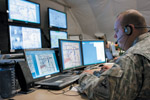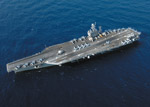Information Sharing Key to Government, Coalition Operations
 |
The major goal of the Interagency Shared Situational Awareness (IASSA) experiment was to provide commanders with an enhanced ability to share information. U.S. Joint Forces Command, which hosted the event, discovered that many of the technical hurdles to information sharing were easily overcome. |
An experiment designed to promote information sharing among
The goal of the Interagency Shared Situational Awareness (IASSA) Limited Objective Experiment, managed by U.S. Joint Forces Command’s (USJFCOM’s) Joint Concept Development and Experimentation (JCD&E) Directorate, was to provide commanders with an enhanced capability to share information with interagency, multinational and nongovernment organizations during a crisis. Held last summer, the experiment focused on three areas of information sharing: geospatial data, file sharing and text communications. Computer models and virtual connections provided participants with a constantly changing environment to simulate an ongoing emergency.
Information sharing between organizations was a requirement submitted to JFCOM through “warfighter challenges,” an annual set of requests for operational solutions submitted by the combatant commands, explains Capt. Timothy Spratto, USN, JCD&E Capabilities Solutions Group lead,
Capt. Spratto states that the experiment focused on sharing information with other partners because, while the U.S. Defense Department is very good at establishing ad hoc, informal networks between the services and its own agencies, it remains a challenge to share data with other
A key goal was improving the ability to share decision–quality views of an operational situation in a distributed environment with all of the participants working from their home stations. The U.S. Department of Homeland Security (DHS) was a major non-Defense Department contributor to the event. Other participants included the combatant commands and outside organizations such as the U.S. State Department and the
The participants used existing systems and standards within current policies to share situational-awareness data. “We didn’t want the artificiality of an experimental environment to allow them to not use their normal processes and normal procedures. We set out to demonstrate that you could do this using everything you have right now, including your existing policies,” Capt. Spratto maintains. He adds that it was understood from the beginning of the experiment that there were few, if any, technological limitations to information sharing. The captain explains that he was certain there would be no difficulty in linking systems together. His expectations were met as the participants were able to quickly begin sharing information.
Information assurance between organizations remains a challenge. Because the participants’ systems were connected in real time, each group had to work through its respective information assurance process to develop policies that would permit data sharing. To work around security issues, JFCOM created an information exchange architecture that allowed users to securely log into the network. “It knew who you were, and that’s what opened up the sharing ability,” the captain says. The DHS helped to program the architecture and hosted it on the Homeland Security Information Network. But Capt. Spratto maintains that a similar capability could have been built on any node in the experiment. He says that this software architecture is not complicated, noting that a programmer could set the system up, debug it and have it running in about four days.
However, the real impediment to the experiment was developing a culture of trust between organizations. Participants had to trust that the other organizations would use information properly and would follow accepted rules and guidelines while sharing information across the network. The event featured varying levels of exposed information. For example, some organizations had all of their data exposed, while others maintained varying amounts of information behind their firewalls. “Rather than detracting from the experiment, that’s just an actual reflection of reality,” Capt. Spratto observes. “There’s going to be people who play at different levels.” As the participants worked through their information-assurance issues together, a culture of trust gradually was built. He notes that as a measure of success, by the end of the experiment, every group that wanted to connect to the network was connected.
 |
 |
The IASSA experiment was built around several scenarios, including a major hurricane and homeland security challenges, to allow a variety of civilian and military organizations to interact with each other. |
Capt. Spratto notes that the JFCOM team began to see growing comfort with text among the participants as they became accustomed to using it for work and sharing information. He says there was a definite increase in collaboration via text chat, with many users working with the application in this operational context for the first time. The captain cautions that he does not imagine that a short-term event can overcome the cultural hurdles in specific organizations, but he notes that at least he introduced many participants to the possibilities that exist.
The IASSA lasted five days. The first two days focused on training and familiarization for the participants. Capt. Spratto explains that subject matter experts were consulted to help design the experiment and the architecture. “When it comes time to play, we don’t want the experts sitting at the console. We want the real people who are really going to have to play,” he says. For example, the DHS participated from its operations center with all of the center’s watch officers and personnel. The captain notes that the two days of training were important to fully educate the staff about their roles in the experiment, adding that operator proficiency allows better measurements to be gathered.
The IASSA was built around several scenarios, with the main goal being to prompt groups to share information. One scenario simulated a major hurricane and involved all of the domestic federal and state organizations. A second scenario was a widespread power outage in
The network and information-sharing aspect of the experiment was conducted solely between
The JFCOM team developed a guide based on the experiment’s results. The document itself consists of about 30 pages of instructions and is intended for use by Defense Department users to share information with other organizations. The captain maintains that the guide will help personnel manage the technical part of the experiment, such as linking together disparate networks. The guide also will help users understand the steps taken to set up the architecture. Users of the guide also can reach back to JFCOM to receive help-desk support. Capt. Spratto adds that JFCOM will use the guide when visiting the commands and other government agencies to demonstrate what was achieved. “Experimentation’s role is to prove that it can be done. Now we need to find some partners that will take this and use it as a prototype, and hopefully improve it,” he says.
Another factor in promoting the guide is to avoid the seduction of the perfect solution. Capt. Spratto notes that it is common in the Defense Department to wait for a 100-percent answer to an operational challenge. But the guide and the lessons learned from the experiment allow commanders to immediately launch their own information-sharing efforts. “You can do it today. You can use the things you have, you can use the standards that are already established and you can use your own processes to make this happen,” he says.
However, the captain points out that the real experiment is not having an organization share information with other groups—it is convincing those groups to participate. “Do they want to share information with you?” he asks. “Everybody imagines that everyone wants to share information because somehow it will make things better. That’s a huge assumption, and it may not be what you think it is,” he warns.
Capt. Spratto notes that the experiment itself does not provide any direct means to move past an organization’s tendency toward secrecy or lack of information sharing. However, the results eliminate technical difficulties as an excuse to avoid sharing information. While data transfer may be a greater challenge at higher classification levels, the captain believes that sharing can be achieved with the necessary will and trust.
The experiment now is transitioning to the field. JFCOM is seeking opportunities to conduct prototyping work on the lessons learned.
WEB RESOURCES
Joint Concept Development and Experimentation Directorate: www.jfcom.mil/about/abt_j9.htm




Comments